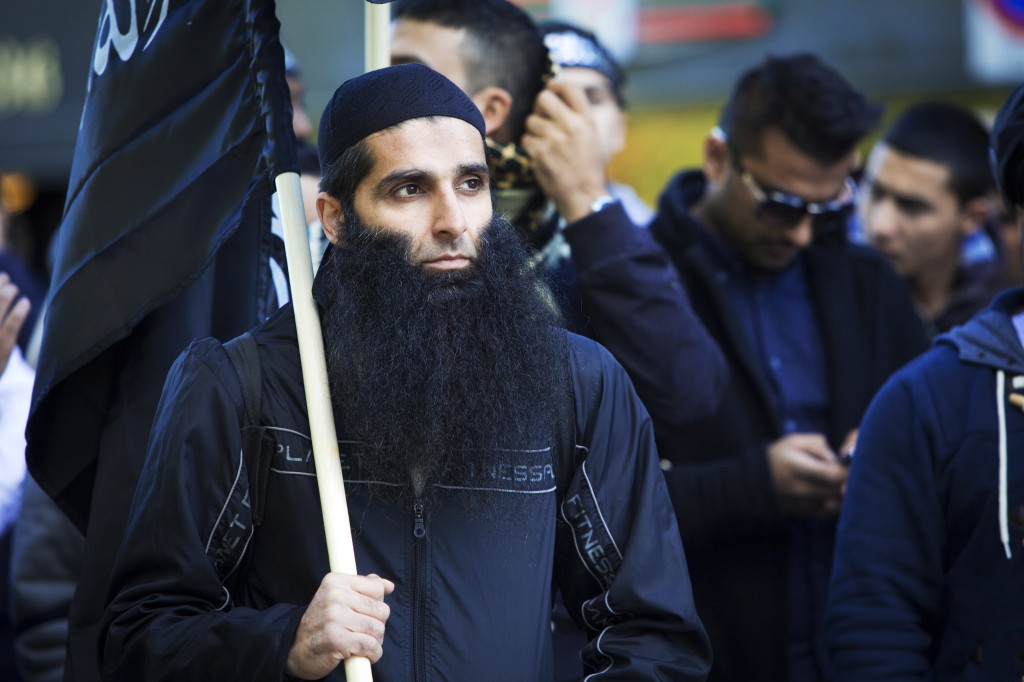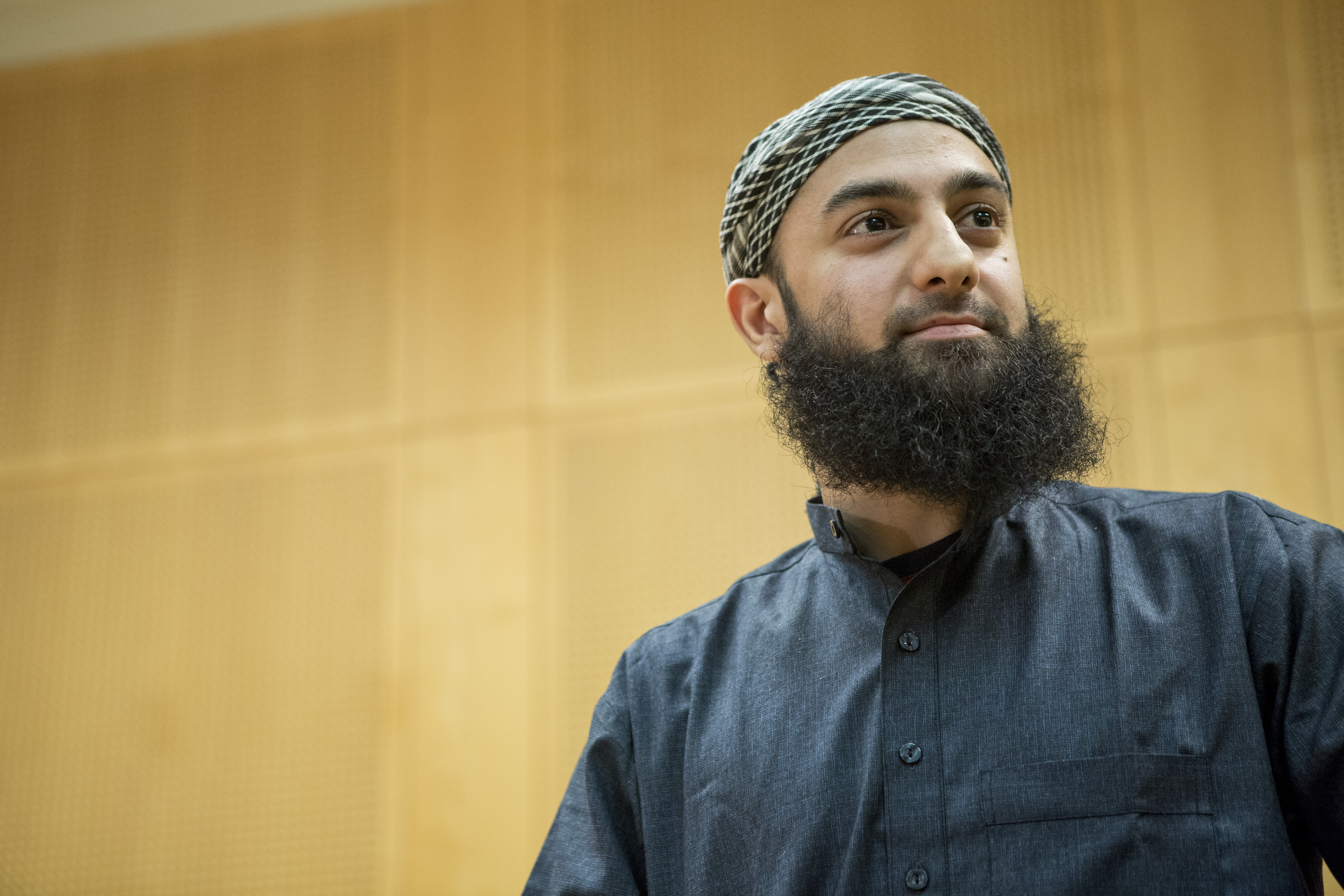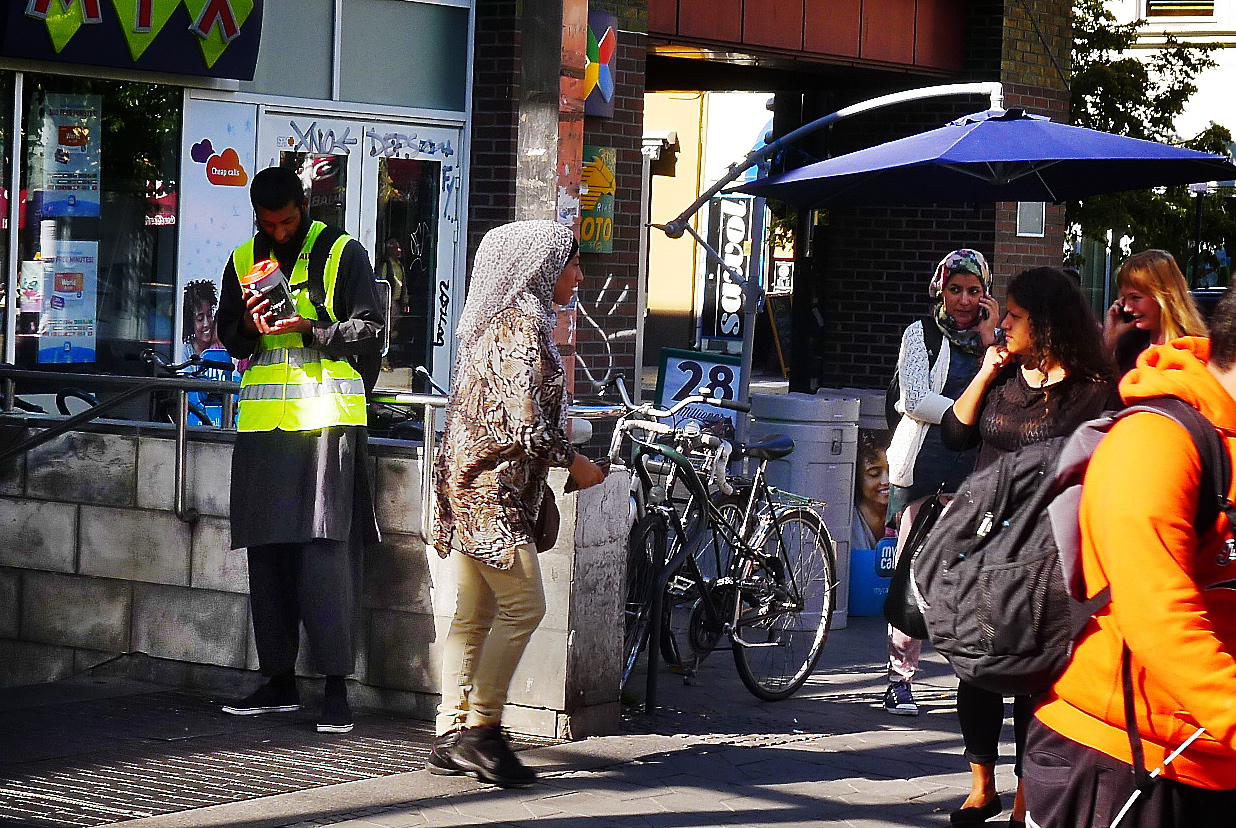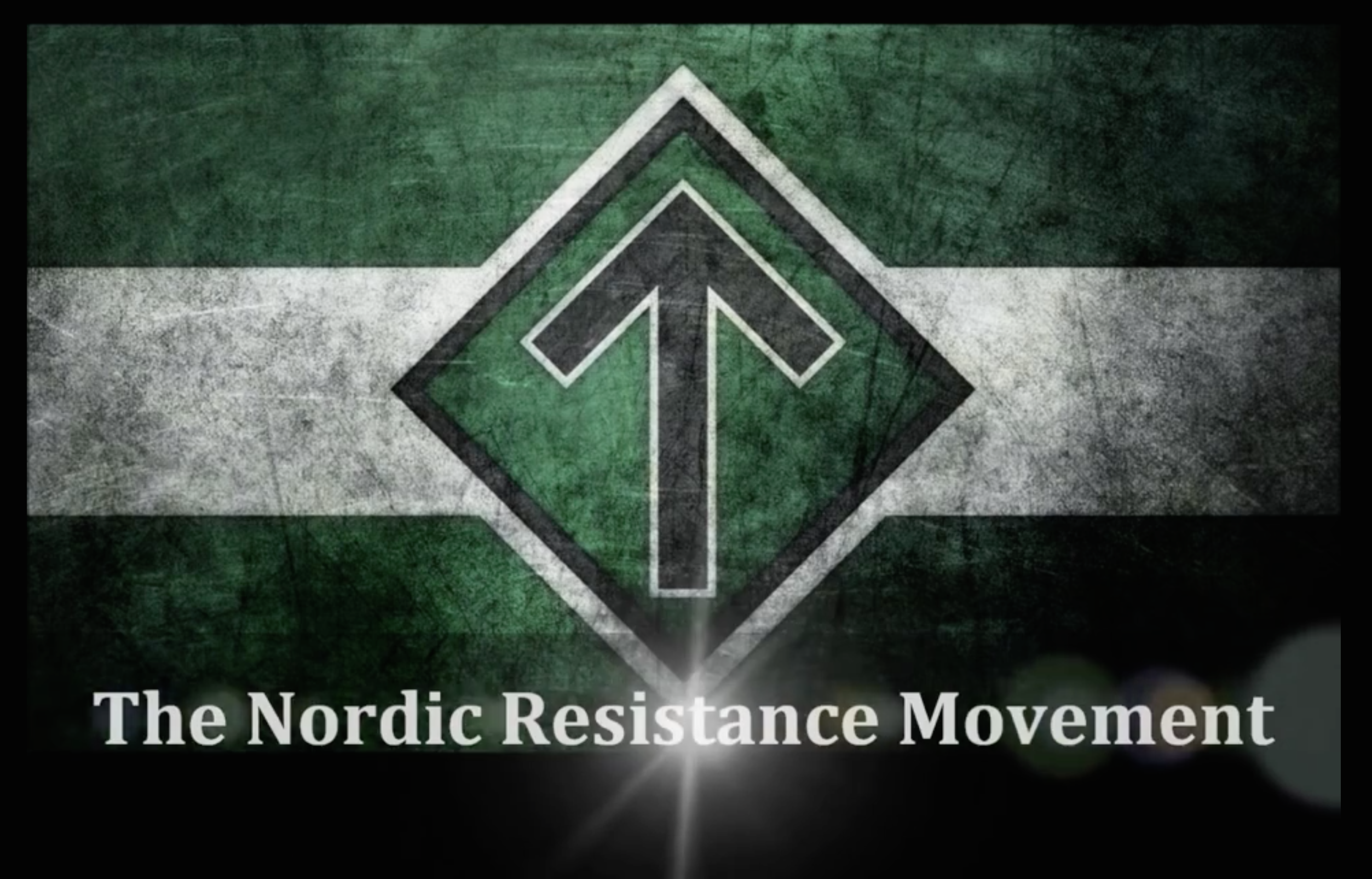ANALYSIS: Despite their strong welfare policies and efforts to integrate immigrants, the Nordic countries are a major source of Syria-bound jihadists.
Lars Akerhaug

The Norwegian radical Islamist Arfan Bhatti at a demonstration against the “Innocence of Muslims” film, outside the US embassy in Oslo in fall 2012. Bhatti is currently imprisoned in Pakistan. Photo: Kyrre Lien, NTB / SCANPIX. Copyrighted.
“Innocence of Muslims” Foto: Kyrre Lien / NTB scanpix
“A young Finn killed while fighting for the rebels”, “Several Norwegians fighting in Syria reportedly killed“, “Swedish jihadists killed in battles in Syria“, “11 Danes killed in Syria“, “20 Scandinavians may have been killed in Syria“.
Since the winter of 2012-2013, more and more headlines like these have appeared in Norwegian, Swedish, Finnish and Danish newspapers. According to intelligence sources at least 75 people have left Sweden to take part in the Syrian civil war on the side of Salafi jihadist groups. From Denmark, Norway and Finland, the comparable numbers are 90, 40 and 30 respectively. That means at least 235 people have left the Nordic countries to fight in Syria – a considerable share of all the foreigners with European or Western passports taking part in the civil war.
Estimates of the total vary between 1,000 and 2,000, with the higher end of the range considered more credible. The Nordic share is remarkably high given the populations of Norway, Sweden, Denmark and Finland and the size of the Muslim diaspora in each country. In comparison, the British intelligence service MI5 has said there could be as many as 200 British fighters in Syria. The population of the United Kingdom is more than double that of all the Nordics put together, and the country is home to a number of high-profile radical Islamists who have stoked discontent. About an equal number of jihadist fighters is thought to have come from France, where an all-out ban on religious headwear in schools and riots in some immigrant-heavy suburbs of the capital have heightened tension between Muslim communities and the majority population. While tiny Belgium may have supplied forces in Syria with as many as 350 fighters, Norway, Sweden and Denmark all rank high on the list of jihadist-exporting countries, especially considering their populations.
This surprising fact can be seen as a challenge to common ideas about why extremist groups grow. Many foreign fighters who are recruited to take part in the Syrian civil war, largely in jihadist groups, come from countries where there is relatively little conflict between immigrants and the majority population, and where asylum seekers benefit from solid welfare systems.
It is hard to identify common traits among the Nordic jihadists that have been recruited, but many do seem to have links to openly radical Islamist groups or circles. These are notable for their accessibility through leading individuals who appear regularly in the press, through demonstrations and other public events and through information and propaganda spread on social media platforms such as Facebook.
The role of Anjem Choudary
Denmark is the Scandinavian country which has had openly radical Islamist circles the longest. The pan-Islamic radical organization Hizb-ut-Tahrir has a strong presence among young Muslims in the country, and radical imams have been present at certain mosques for decades. Many jihadists who have travelled to Syria, however, have a connection to another group: Kaldet til Islam (The Call to Islam), which appears to be inspired by the proscribed Salafi-Wahhabi British group al-Mujahiroun. This British group has effectively operated under a number of other names, including Sharia4UK. It was formerly led by Omar Bakri, who has had contact with Kaldet til Islam. He left the United Kingdom for Lebanon in August 2005, has since been banned from entering the United Kingdom and – the BBC reported in early April – is currently on the run in Lebanon, wanted on charges relating to endangering national security.
Today the central figure is British-Pakistani lawyer Anjem Choudary. This group might be seen as the very prototype for an open, radical Islamist organization. Members publicly announce their activities, and the group is easily accessible. Choudary gives public speeches, easily available in central London, just a short walk from the popular Brick Lane. The group also receives considerable media attention by making controversial statements, staging provocative demonstrations and attempting to create “Sharia Zones”. In 2013, the British anti-racist and anti-extremist organization HOPE not Hate (HNH) released the report “Gateway to Terror”. HNH reported that while Choudary might not have been directly involved in terror plots, he had “helped shape the mindset of those behind them, indoctrinating them and linking them up to terror groups and supporters across the world”.
Kaldet til Islam’s front figure, Shiraz Tariq, died in the Syrian civil war last fall, according to a “martyr video” posted online. He reportedly fought together with the Islamic State of Iraq and the Levant, abbreviated ISIL or ISIS.
In 2012, members and sympathizers of Kaldet til Islam gathered at Kongens Nytorv, a public square in central Copenhagen. “Those who insult the prophet shall be killed,” Omar Bakri told the audience over a phone line from Lebanon.
The Ummah of the Prophet
In Oslo, Norway, a similar group has been established: Profetens Ummah (The Ummah of the Prophet), formerly known as Ansar al-Sunnah. As an organization it took form in 2013, springing from an older, more informal group. Its roots may be found in a large demonstration against the daily newspaper Dagbladet, which published a picture of an anti-Muslim caricature depicting the prophet Muhammed as a pig in connection with a news story in 2010. The article in fact described how links to anti-Muslim material were posted by people commenting on the Facebook page of the Norwegian intelligence service. One of the key sources in the story was Arfan Bhatti, a major figure both in Profetens Ummah and in the subsequent demonstration. In the story he was photographed alongside a computer screen showing the caricature. A network in existence since 2010 has occasionally drawn public attention and issued threats against politicians and other officials.
When Profetens Ummah was launched, it called on supporters to demonstrate outside the US embassy in Oslo. At the same time, group leader Ubaydullah Hussain announced a number of “durus”, or courses on Islam, in a mosque situated in a loft above a vegetable grocery in the Norwegian capital. In other words, those who were curious could easily seek out the group to get more information.
The Norwegian and Danish groups have much in common. Both are in principle Daawah groups, meaning that they consider it a duty to proselytize for their version of Islam. (Daawah is Arabic for “calling to Islam”.) Central to their understanding is the concept al-walaa wal-baraa, or “calling to the good, and banning the evil”. They believe Muslims must explicitly spread the message of Islam in Western countries, including the wish that these countries become part of an Islamic caliphate governed by a rigid interpretation of Islamic Law. They also believe that Muslims are obliged to “ban the evil” in these countries, to the extent possible. In other words, their activism goes beyond traditional Muslim missionary work and even surpasses that of Salafist networks supported by Saudi-Arabia and Tablighi networks that receive support from Pakistan.
Kaldet til Islam and Profetens Ummah hold demonstrations in which participants carry black flags and Arab slogans. They make provocative statements, call for Sharia Zones and issue other futile demands. Both groups have threatened politicians and other officials, thereby drawing attention to themselves from the media and from intelligence services. This may seem counterproductive to the goal of sending young men to fight in Syria, but the strategy appears to have worked. One reason is that in Scandinavia such groups are permitted to propagandize more openly in support of terrorist groups than their counterparts in much of the rest of Europe. The chances of being prosecuted are small, unless direct threats are made. Another reason may be that Scandinavian countries currently have no legislation barring people from travelling to take part in the Syrian civil war or to seek training in terrorism. For the authorities, it is difficult to punish holy warriors abroad, and when they return it is often difficult to prove they are guilty of a crime.
As might be expected of two groups with so much in common, they are in communication. When Anjem Choudary visited Oslo in the fall of 2012, a group photograph showed the presence of both Norwegian and Danish radical Islamists. Also present was a Swede from Borås.
In Sweden, there is no similarly open Islamist group and it is harder to find extremists who support violence and encourage youngsters to go to Syria or other countries to take part in the jihadist struggle. The Swedish media also devote far less attention to radical Islamist circles, in spite of a number of Swedes having been involved in terrorist activities. The Swede from Borås is one of several with links to Choudary and Bakri. Taimur abd-al-Wahhab al-Abdaly, who blew himself up in a shopping street in Stockholm just before Christmas 2010, reportedly studied with Omar Bakri. The former Guantanamo prisoner Mehdi Ghezali reputedly also has had contact with both Bakri and Choudary. Several relatives of Omar Bakri reside in Sweden, among them one of his sons, who is active in his organization.
From Sweden and Finland
In spite of the lack of open groups such as Kaldet til Islam, the Swedish journalist Per Gudmundson‘s research show that a considerable number of jihadists have travelled from Gothenburg to Syria. Many grew up in suburbs surrounding the city, and some have been active in the Bellevue mosque, which has a reputation of domination by Islamists. Swedish radicals fighting in Syria have also spread battlefield propaganda via Facebook and via videos posted elsewhere on the web, encouraging young Swedes to travel for holy war.
We know less about Finnish Islamist extremists. But among them, too, it is possible to detect signs of the movement around Anjem Choudary. In March 2013, Choudary visited a Helsinki conference held in support of the jailed Norwegian Islamist known as Mullah Krekar, the former leader of the Kurdish-Iraqi extremist group Ansar al-Islam. “Be proud of being called terrorists,” Choudary told the Helsinki audience.
The role of social networks
Despite the connections and commonalities among international extremist groups, there is reason to believe that recruitment in Scandinavia takes place largely through social networks. In Denmark, Norway and Sweden alike, most extremist circles have emerged from specific local communities, sometimes even exploiting family connections. It is difficult to say why some groups seek publicity and others choose to keep in the background. Some clandestine groups are likely to remain unknown, while others that would prefer to lay low have been mapped by journalists and other investigators.
Most such networks take it for granted that they are being watched by security services, and often believe that the services possess much stronger capabilities than they actually do. Opting for a public profile may be a calculated choice, seen as a way to maximize recruitment in a situation where it is assumed that opposing forces know of their existence in any case. In Scandinavia, openness about the use of social media and other platforms in the public sphere appears to have fuelled the growth of radical networks.
For the security services, such openness is a boon to the extent that it makes mapping the groups easier. But if propagating in the open results in larger extremist groups, the Nordic security services with their limited resources may ultimately find themselves working harder.


 Print Friendly
Print Friendly







The problem is that Scandinavian countries are extremely racist, totalitarian, tribal societies and there is just no practical evidence of any effort for integration. Both, the state and almost any member of society has a deep hatred and fear of anyone who is of other ethnicity.
But they do not want to admit it. That is why the world sometimes wonders how so much evil can originate from so “humane” countries.
Another point is almost complete inability to counteract extremist efforts to recrute young people who were disgorged by those inhumane Scandinavian societies. This inability roots in ideological idiosyncrasies and direct stupidity. Scandinavian countries lack human resources, humans who together could make a difference.
My opinion is mainly based on experience from Norway.